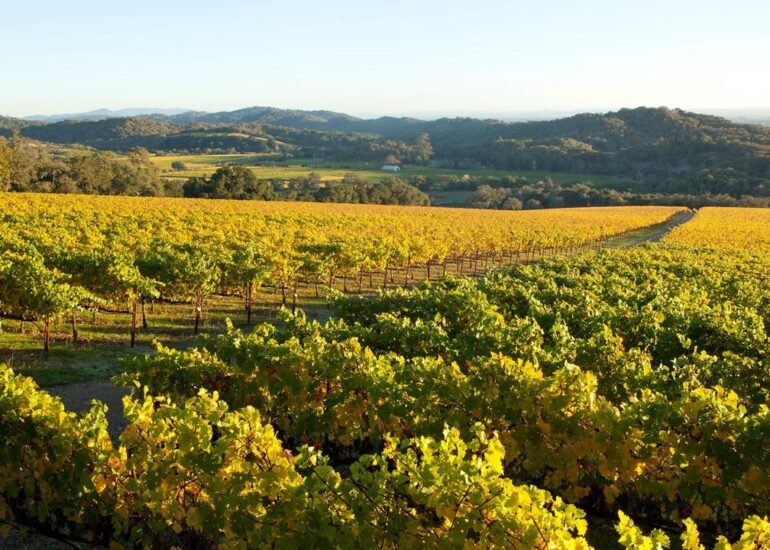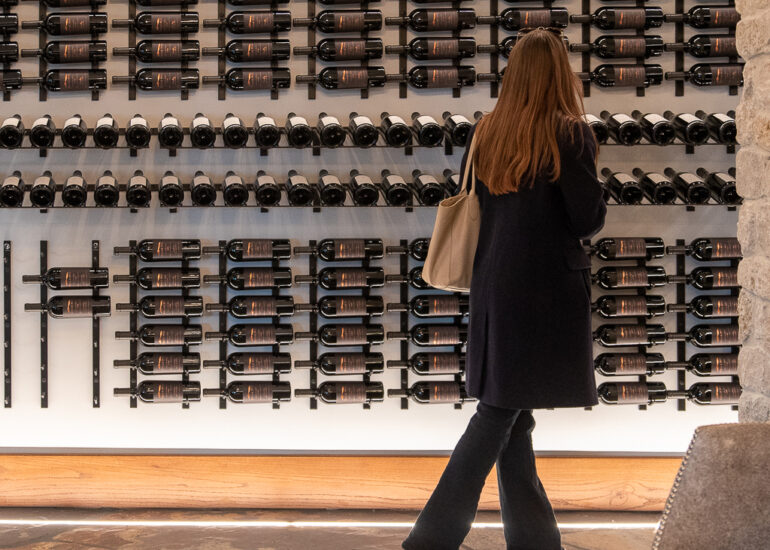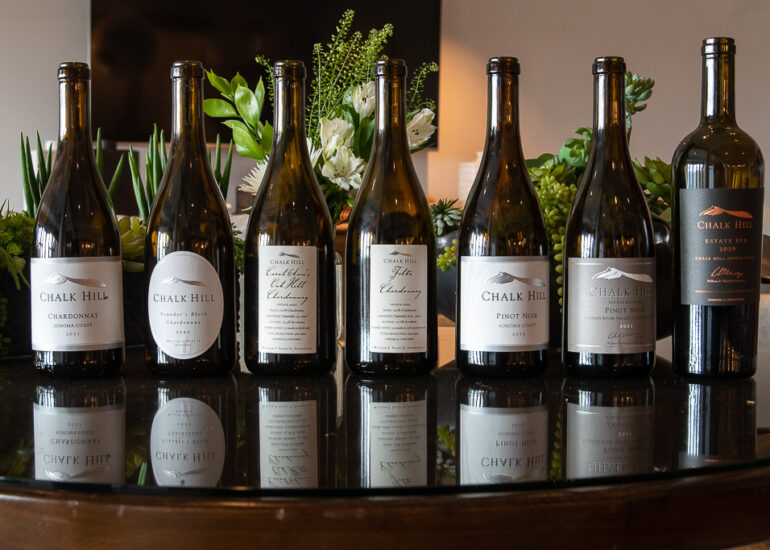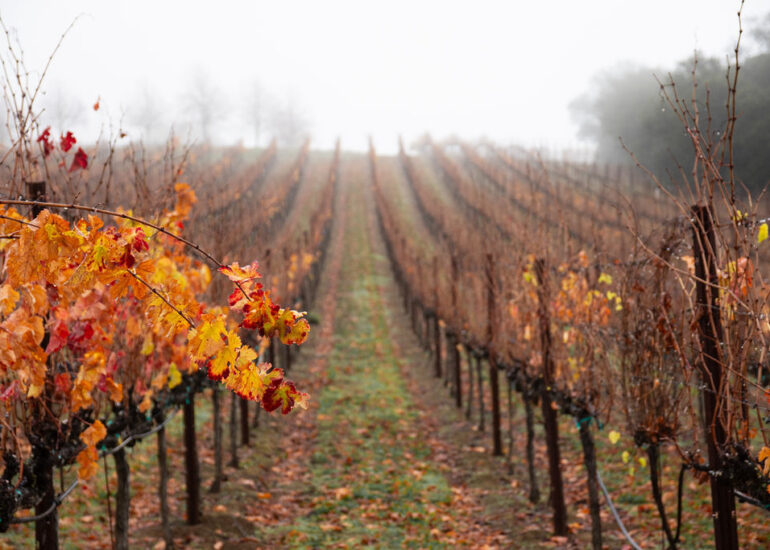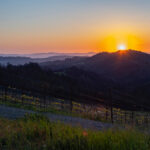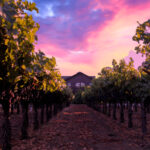Chalking It Up
Winemaker Interview
Chalking It Up
A conversation with Jordan Fiorentini of Chalk Hill Estate in Sonoma's Chalk Hill
Eastern Sonoma Winery Asserts its Singular Style Amidst Geographic Diversity
An Interview with the Winemaker of Chalk Hill Estate
Very few premium wineries in Northern California can boast of vineyards that lie on a single estate of nearly 1,400 contiguous acres. Even fewer enjoy the advantage to their wine production afforded by an expansive landholding that features widely diverse vineyard soils and sharply varying topography. Chalk Hill Estate, however, proudly claims both. Situated within a small appellation bearing the same name, on the eastern end of Sonoma County, it also benefits from climatic patterns unique to its locale. As if these practical attributes in themselves weren’t enough, the estate readily reveals to visitors a natural charm with undulating green hillsides, tranquil lakes, and meandering streams, along with the aesthetic allure of architecture that gracefully blends into the scenery. Following a comprehensive tour of this broad and bucolic landscape, I spoke with Jordan Fiorentini about the significance of Chalk Hill’s features to its vineyard management and winemaking.
Because it’s nestled in what effectively amounts to a climatic pocket, Chalk Hill’s location and topography make for unique grape-growing conditions. Protection by the Mayacamas Mountains from the hotter extremes of neighboring Alexander and Knights valleys (to the north and east) is further compounded by the cool marine air coming through the Russian River Valley (to the west). The result is a climate that’s ideal for growing the rich and expressive white wine varieties on which the estate has built its reputation. Recent planting of a warmer hillside area with robust red varieties has augmented the brand’s portfolio with red wines that showcase a brighter style that’s increasingly drawing market attention while remaining true to the overall brand. I sat down with Fiorentini to taste and discuss the wines of Chalk Hill, experiencing for myself how well they manage to express nuances of the estate’s vineyards and maintain wide consumer appeal.
— Nikitas Magel
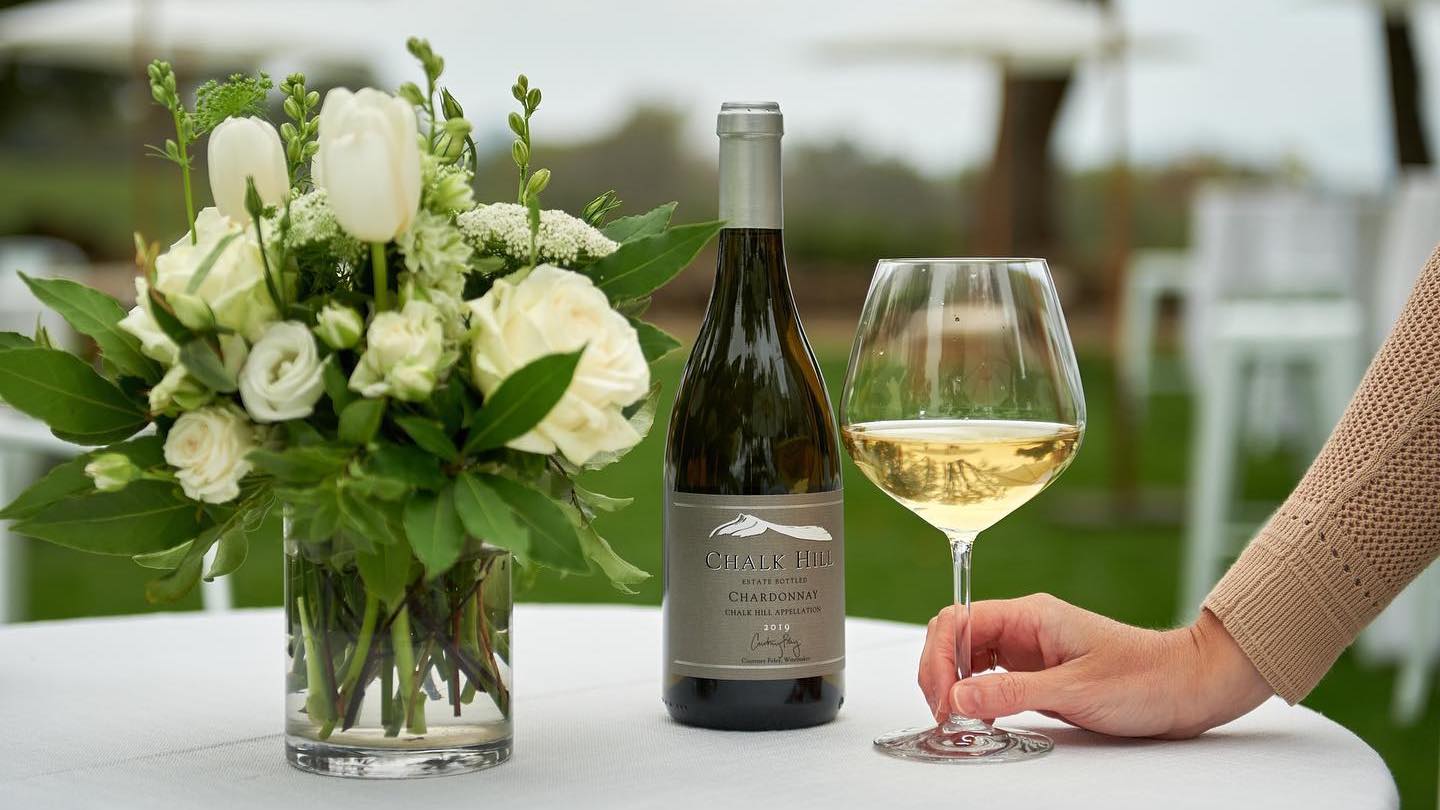
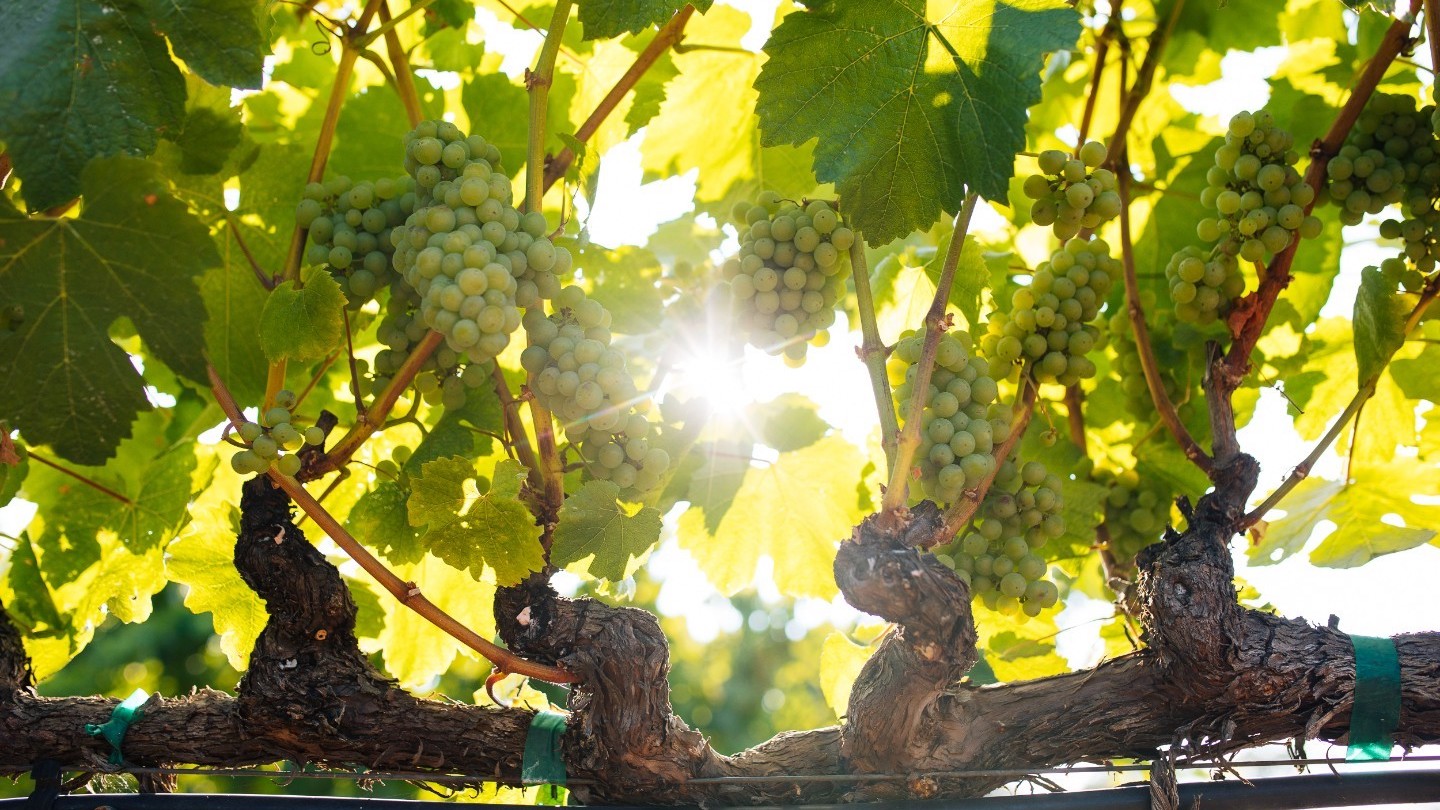
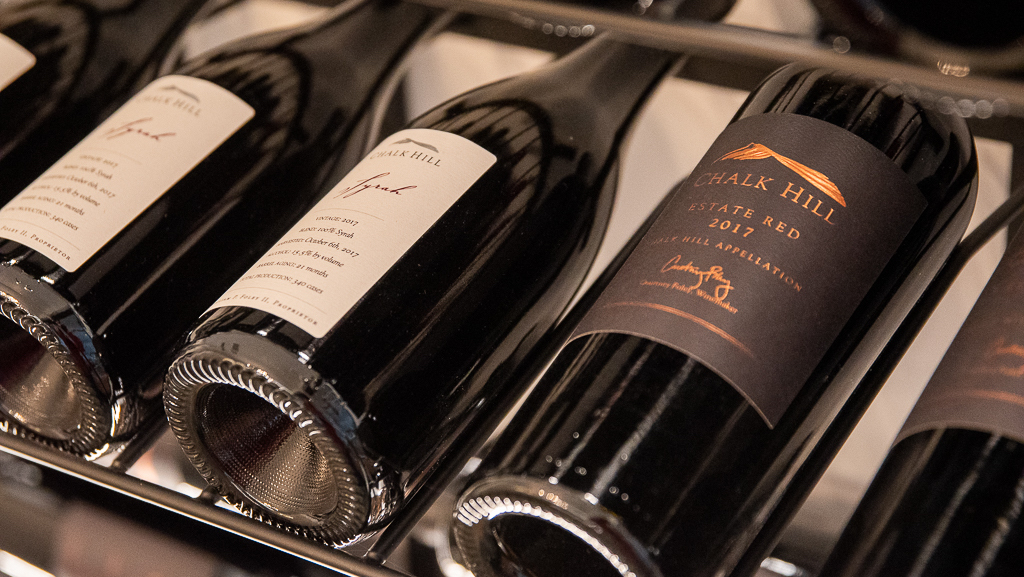
A Sub-appellation of Substance
Nikitas Magel: Many consumers might not know this, but Chalk Hill is the name not only for this estate and its winery, but also for this area, this appellation.
Jordan Fiorentini: It’s a sub-appellation of the Russian River Valley, but it’s also a stand-alone appellation.
NM: I understand that the soils are extremely varied, even just alone here on the Chalk Hill estate. How do you manage that variability in articulating the wines themselves?
JF: The soil and aspect really dictate what can be planted where. But because we’re a 100% estate-produced winery, we’re limited to where we can plant our grape varieties. Where those varieties do grow, they start to give you a sense of place, so even though the soils themselves are varied, within each planted variety there’s a good deal of consistency. And that’s based on a lot of clonal research, since we have so many different clones planted of every variety. In fact, we’ve actually been at the forefront of Chardonnay clonal research since we began [in the early ’80s] — we have one vineyard that has 22 different clones of Chardonnay planted to it, where we do trials and figure out which clones we like. So, if we wanted to change any part of our production over to another clone, not only would we already know what we like, but we’d also have the wood to do it with, since we harvest our own wood and do the grafting and T-budding right there in the [research] vineyard. Based on the evaluation of all the clones from that vineyard, we currently have about twelve of them planted throughout the estate that we’ve found are really good Chardonnay clones.
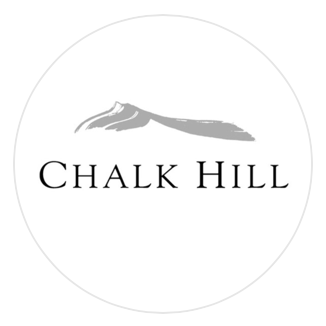
NM: That’s great that you have the resources to do all that research! It obviously allows you to make better wines that reflect this place. What would you say is your greatest pleasure in making those wines?
JF: I love the fact that the wines really speak of where they’re from. My goal in winemaking is to make wines that are very unique and truly express the estate, especially being that they’re coming from such an exciting place, a place that has such an amazing story! To have the wines express that story is constantly my goal, so I’m always doing a lot of proprietary research to try to figure out how to bring the flavors of the vineyard out in the wines.
NM: On the flip-side, what would you say is the more challenging aspect of working with the vineyards on this estate?
JF: I think the biggest challenge is the cooler vintages, especially for the reds. In those vintages, we’ve had to really manage tannins because a lot of our vineyards are on hillsides, and that’s meant watching tannin extraction during fermentation. In cool vintages what we’ll do is pick in November, if we have to, because even once the days get shorter [and cooler] and the vine leaves start to fall, the tannins will still polymerize just with sunshine alone — even after sugar accumulation has stopped. But it’s definitely tricky; it’s a waiting game with the reds here. To put things in perspective of what’s really challenging, though, there was a time I worked with Sangiovese in Tuscany during a very rainy season — now, that was difficult!
Honing the House Style
NM: What are some of the things you do to maximize finesse in the wines? And might the cooler climate invite longer hangtime, risking higher alcohol levels?
JF: We’re purists because we try to bring out the vineyard in every wine that we make. We use almost 100% native yeasts in our fermentations, and we do a lot of lees inclusion in our Chardonnay, which would be almost as if we didn’t settle the juice. We don’t fine, we don’t filter. And these are things we’re already married to. In terms of other manipulations that would decrease alcohol — whether it be water addition or de-alcoholizing — that’s against everything that we stand for! I think that people who are tied up [with the high alcohol issue], “Oh, California wines are so high in alcohol, and European wines aren’t” — they don’t understand that we simply cannot pick our fruit at a level of sugar to have a comparably low level of alcohol and still have a ripe wine! At that alcohol, the wines would have super green flavors and tons of acid, because the fruit won’t have had that much hang time. I think people need to understand that, and just taste the wine and not be so concerned with what the alcohol level is. I’m concerned with it only if it’s going to show through [and make the wine imbalanced]. But if it doesn’t show through because the fruit is ripe, rich, and complex, then it’s just part of the wine being from California.

NM: Let’s talk about the wines themselves, starting with the Sauvignon Blanc. It’s made in a rounder, creamier style, similar to the other white wines in Chalk Hill’s portfolio. Tell me about that choice of style and what you do to achieve it.
JF: All of our whites are 100% barrel fermented; they’re not tank-fermented. Normally with whites, you’d go directly to press in order to get the freshest possible fruit flavors, but we actually do a little bit of skin contact on our Sauvignon Blanc to get some more of those flavors out of the skins. After sitting in the closed-tank overnight, we press it out the next morning, at which point the glycocides that are bound in the skins are released into, and then become part of, the aromatics of the wine during fermentation. But we do that on just a small percentage of our Sauvignon Blanc because with all those aromatics, we’re also getting textural and phenolic components. To have that much texture in a wine that’s undergone 100% skin contact might be great for some people, but not everyone, especially with a Sauvignon Blanc.
The 2006 Sauvignon Blanc is a combination of regular barrel fermentations with native yeast. The only time we use innoculated yeast is if we don’t do a lot of skin contact, which is about 25-30% of our production. And then we do some stainless steel barrels, as well. The total is about 18-20% new French oak. We have certain amount of lees inclusion that we like to take from the settling tank of the juice during fermentation, and do battonage during fermentation (though it goes through no malolactic) and continue the battonage as long as the wine needs it. Sauvignon Blanc can be a reductive variety, so we want to make sure that we’ve worked the lees enough to release the complexity into the wine and also ensure that no reduction might start to occur.
NM: So, with the Sauvignon Blanc, you stirring the lees but ensuring the wine goes through no malolactic fermentation. Those two techniques arguably have somewhat similar results in a finished wine. How would you describe the the difference between them, and why choose one over the other?
JF: Stirring of the lees can give creaminess, fullness, and body to the wine. If you weren’t stirring the lees at all, you might be able to get some of that through malolactic, but you’re also going to get a different type of ‘cream’ because the process is changing the malic acid to lactic acid. And that changes the acid profile. So, if you’re just stirring the lees without doing ML, you’re building creaminess while still retaining acidity. Sauvignon Blanc is the one variety for me that if you walk through the vineyard and taste the fruit, the flavors you taste are actually what you ultimately get in the finished wine. Reds can be that way sometimes too, but with Sauvignon Blanc the connection is so direct. And the grape is often affected the most just by handling it, because it’s so aromatic. So, we expose it to no oxygen at all during any part of the winemaking process since we don’t want to lose those aromas. Because over time, though you gain a fuller palate and bottle bouquet, the aromatics do tend to round out a bit more. Sauvignon Blanc is very delicate. Whereas with Chardonnay, you can really push those limits. Chardonnay is such a winemaker’s wine because there’s so much done in the cellar that builds character.
NM: Tell me about Chalk Hill’s Chardonnay and what you’re doing in the cellar to articulate the current style.
JF: Chardonnay, like I said, is a winemaker’s grape; it’s very often built in the cellar through things like batonnage and aging. In our Chardonnay, we do a great deal of lees incorporation. We put it all into the barrel and ferment from there, with lots of batonnage. It’s a 100% native yeast fermentation, with 100% malolactic, in about 45% new French oak, with aging for about 10-12 months. Also, we don’t fine or filter. The 2006 Chardonnay reached a natural clarity that was a little bit cloudier than we would have liked, but the wine is probably bigger because of it, since lees give texture and mouthfeel to a wine.

NM: I applaud the risk you took in finishing the wine with some cloudiness! My feeling is that when someone is willing to pay for a good bottle of Chardonnay, they don’t need to be coddled into believing that the wine has to appear crystal clear. At this level of quality, some haze might actually play to your benefit.
JF: I’d love to have that information printed on all the back labels. Though right now, it is written on the 2006 Pinot Gris: “This wine is unfiltered and unfined to preserve its unique and natural character. A hazy appearance or light sediment indicates our gentle winemaking practices and our dedication to quality.” And that’s exactly what it is! I even tell people that when I get a great Chardonnay, one that really I like, and it’s crystal clear like water, in my head I think, “How much better could this wine have been were it not filtered to make it so clear?” But there are really two camps: one in favor of filtering, the other against it. And the two can’t argue with each other. You just have to decide if you’re going to filter or not. If not, you figure out a way to make it work and to deal with all the consumer issues that might arise, which you’re always dealing with anyway. This is what we believe in and what we’re doing; it’s about practicing minimal handling wherever we can. But you can also get a wine crystal clear just from fining alone. There are winemakers who don’t even filter, but they heavily fine. And that can be more damaging to the wine than filtering it — I truly believe that! Either one, though, can be damaging if overused, because in both cases you’re doing something to the wine: using pressure to push the wine through something tiny [with filtering] or adding something to it, which drops out a lot of compounds [with fining]. Of course, it all depends on how these things are done; if you’re careful, they don’t necessarily cause problems.
NM: After tasting some of Chalk Hill’s white wines as a group, they all seem have a common theme or signature. How would you articulate that into words? And what does Chalk Hill aim to offer the consumer with its portfolio of white wines overall?
JF: White wines are very transparent — literally and figuratively. You’re going to be able to pick up where they’re grown, I think, more easily than most of the reds (other than maybe Syrah). Having said that, our desire to make the most of this site and its fruit is maximized with our white wines in general. Chalk Hill wants to show consumers what the appellation and what the estate, specifically, can do. And I think they show it very well, because there is that commonality among the whites, too — a ‘high-toned’ underlying minerality. I also think Chalk Hill Estate aims to create varietally distinct wines, but which are still laced together. Someone may not normally like Sauvignon Blanc, but they’re almost sure to like ours if they already like our Chardonnay. In the end, we want to have people trust our product, so that they might say, “I’ve never heard of Pinot Gris. But, oh, it’s a Chalk Hill and I love their Chardonnay, so I’ll try it!”

Expanding and Experimenting with Reds
NM: And it’s with its white wines that Chalk Hill Estate has built a good deal of its reputation. Which makes perfect sense, given the cooler meso-climate of this appellation. Yet, there’s been a recent thrust in your red wine program. Tell me about that. And how much of it stemmed from the planting of the warmer site you mentioned, where reds seem to do very well?
JF: The recent planting of the [warmer site] vineyard marks a huge shift in our red program. We’ve had three vintages in a row recently that have been fantastic. But having that vineyard now, we’ll be able to produce some phenomenal wines even in cool years because it’s fantastic for growing red grapes. It’s southern-facing and has very intense, cobbly volcanic soils that are just perfect for red grapevines. We’ve got our Cabernet over there, our Syrah on the lower slope, and then some Malbec.
People sometimes ask how we can grow so many different varieties, both reds and whites, in one single area. And the reason is that the soils are so diverse and the estate is so large, so we can cherry pick, and we’ve done that through trial and error. There are all these back-hoe pits dug to show the different patterns in the soils, which helped to figure out which way to lay the vineyards. That [warmer site] vineyard is really more like Alexander Valley in terms of its soil makeup, but especially in terms of its temperature. Unlike some of the other (hilltop) vineyards where we have a lot of the white varieties planted, that vineyard is warmer due to its aspect towards the sun and because it doesn’t have the constant, cooling breeze coming directly from the ocean. It’s amazing how a cool, breezy area will affect ripening.
NM: You mentioned having Malbec planted in that vineyard. Malbec is not at all common and is still relatively unfamiliar to consumers in the marketplace. Tell me about the decision to plant Malbec and about its blending with some of the other red varieties.
JF: The Malbec has been planted for a little over ten years. The decision to plant it was out of a desire to experiment with the property. As a blending wine, it goes really well with the Merlot because of its prominent fruit profile. I always think of Merlot, when it’s really good, as having a lot of blue fruit qualities — same with Malbec, so they go really well together. The Malbec really helps the Merlot because of its structure. In fact, our 2006 Merlot is 20% Malbec. Normally you’d want to blend Cabernet Sauvignon into all your reds to give them structure and longevity. But I think Malbec can do that very well for Merlot; it’s one of the most structured grapes other than Cabernet. With that said, it’s not like we have to add Malbec to our Merlot. We usually pick out our favorite lots of the other varieties and try to blend them in, to make the wine better; Malbec just happens to be the one that, year after year, was a slam dunk. It adds stuffing to the Merlot, and the fruit really pops with the Malbec — plus, it gives the wine more depth. The soft midpalate is really all Merlot, whereas Malbec, again, gives more of the structure.

NM: Speaking of Chalk Hill’s Cabernet Sauvignon, there’s a great deal of softness and bright red fruit to the wine. I find that to be very typical of coastal Sonoma Cabernets in general. And this one definitely shows its cooler origin.
JF: And this is a Cabernet that’s going to age and age and age! I had a group of French people here tasting our wines, representatives from the cooperages, and they loved this wine. It’s coming into its own right now, but it took it a long time. Plus, there’s still the question [in the industry]: Can you really age a super-ripe Cabernet? The jury’s still out on that, right? Whereas I know that this Cabernet is going age, phenomenally. It’s got so many levels of complexity because we get a really long, cool growing season. We pick in November, so you can imagine how many different flavors develop in the fruit along the way!
NM: But out in the marketplace, California Cabernet brings with it a certain expectation of flavor, ripeness, and texture. How do think that Chalk Hill’s Cabernet is sitting with that expectation?
JF: I go back what I mentioned earlier. Our belief is that a consumer will think, “Since I already trust Chalk Hill for their Chardonnay, which I love, now that I want to buy a red, I feel confident to try their Cabernet.” Plus, tides are turning among critics. They’ve recently been turning attention towards Sonoma County reds, and that’s opened the door in the marketplace for the style that red wines tend to have here. But it’s also a trust factor with consumers; we always have to make sure that we meet expectations they might have with our reds, based on what they’ve come to expect from our Chardonnay. Thankfully, a number of things have happened all around the same time, allowing our red program to gain a real foothold: production from the new vineyard we have [where red varieties are primarily grown], higher praise in the wine media for reds in general from Sonoma County, and three warm vintages in a row that are just now hitting the market. You would think someone who drinks Chalk Hill wines would be a Chardonnay drinker, but we have people in our wine club who only want red wines!
Aiming for the Artisinal
NM: Bringing it full circle, what would you say are the most rewarding aspects of making wine in general for Chalk Hill, especially given this high level of quality in the context of what we might consider a sizable amount of production?
JF: Because we’re at 30-35,000 cases — which, although not tiny, is definitely not big — I’m able to come up with interesting club wines. We do tons of trials, so there’s room for that and a real appreciation for it, too. And then within that we’re culling out special wines. It’s great! We’ve made them all in this high-end winemaking style, so we can charge a bit more because we have the audience who appreciates them. And that’s a lot of fun; it’s definitely the highlight of my work here. Now everyone is realizing that the direct [-to-consumer] market is the way to go. So, it’s nice that we have the club already established. And I have no restriction with these wines as long as I make no less than two barrels of whatever I want to make — we can do a club wine on anything!

NM: Now, that’s exciting! Because with the club wine program, you have what amounts to a canvas where you have a lot more artistic license than with the the standard portfolio, which I’m guessing has been great for your professional development. On that subject, what have you learned in making wines for Chalk Hill that has really shaped your identity as a winemaker and your understanding of winemaking at its core?
JF: There are several things. First has been bottling wines unfiltered — there’s no safety net with that, so I have to be on it from the get-go and be thinking about it from the beginning. Second has been developing and having a goal of what I’m trying to achieve in the glass — I probably would have had that at this point in my winemaking career anyway, but it happened to coincide with me being here and having these different varieties to work with. I’ve also learned the importance of being honest with myself while tasting, really trusting what I taste; if I don’t trust what I taste in the moment, then I know I shouldn’t make any decisions at that point, but should come back later. I ask myself: “Do you like it, or do you not like it? If not, then don’t try to fool yourself into thinking that you do.” I don’t let myself [fall into that trap], because I always taste blind.
NM: How are you able to reconcile that high degree of trust you’re placing in your palate and in your winemaking judgement overall with the fact that the reputation of this winery, with its a high profile in the marketplace, is resting on your shoulders?
JF: You can’t think of that; you just have to do it. Not that I’m comparing myself to a great artist, but this is where the art comes in. If you knew that you were going to be making a masterpiece — say, if you were Michelangelo or DaVinci — would you really be able to start that project, focused only on what it would become? With wine, it’s easier because you’re under a time gun; each vintage dictates your pace. But the principle is the same. You can’t focus on that big of a picture in the moment, otherwise it would drive you crazy! The only things I have are my palate, my past experiences, and my references, the people I can call. That’s what I have. So, I really have to trust in my palate. And that’s why you have winemaking practices, to have this frame of work that organizes you. But it’s difficult, it’s really difficult. It’s hard to know, for example, in one vintage, if I should leave the wine on the skins longer or not, because I don’t know what it’s going to do. Every year, I gain knowledge — but then again, every vintage is different!

NM: And so, broadening the focus here, what have you learned in the process of making wine that you’ve been able to apply to your own life and personal growth?
JF: Hmm… Winemaking has so many different aspects to it. It has the science, it has the art, and then there’s all the people you work with. It’s a very interesting career. I think what I’ve learned in all this is the importance of being true to yourself; that’s pretty much the bottom line. If I’m able to make a certain decision with some situation at work, then I should have the confidence in myself to do the same with life in general and really trust in myself and my abilities. You have to state your opinion, but there are many different ways to do that, to get your point across. So, it’s about managing and working with people, but also about trusting in your abilities.
Trusting in ability is also what the Chalk Hill brand has enabled its customers to do. By crafting wines with grace, intensity, and character while staying true to its mission of expressing the nuances of its vineyards, Chalk Hill manages to strike a balance between consistency and singularity. To learn more about this producer and its portfolio of wines, visit Chalk Hill Estate online.
Interview by Nikitas Magel
Photos by Chalk Hill Estate

Comments are closed.

